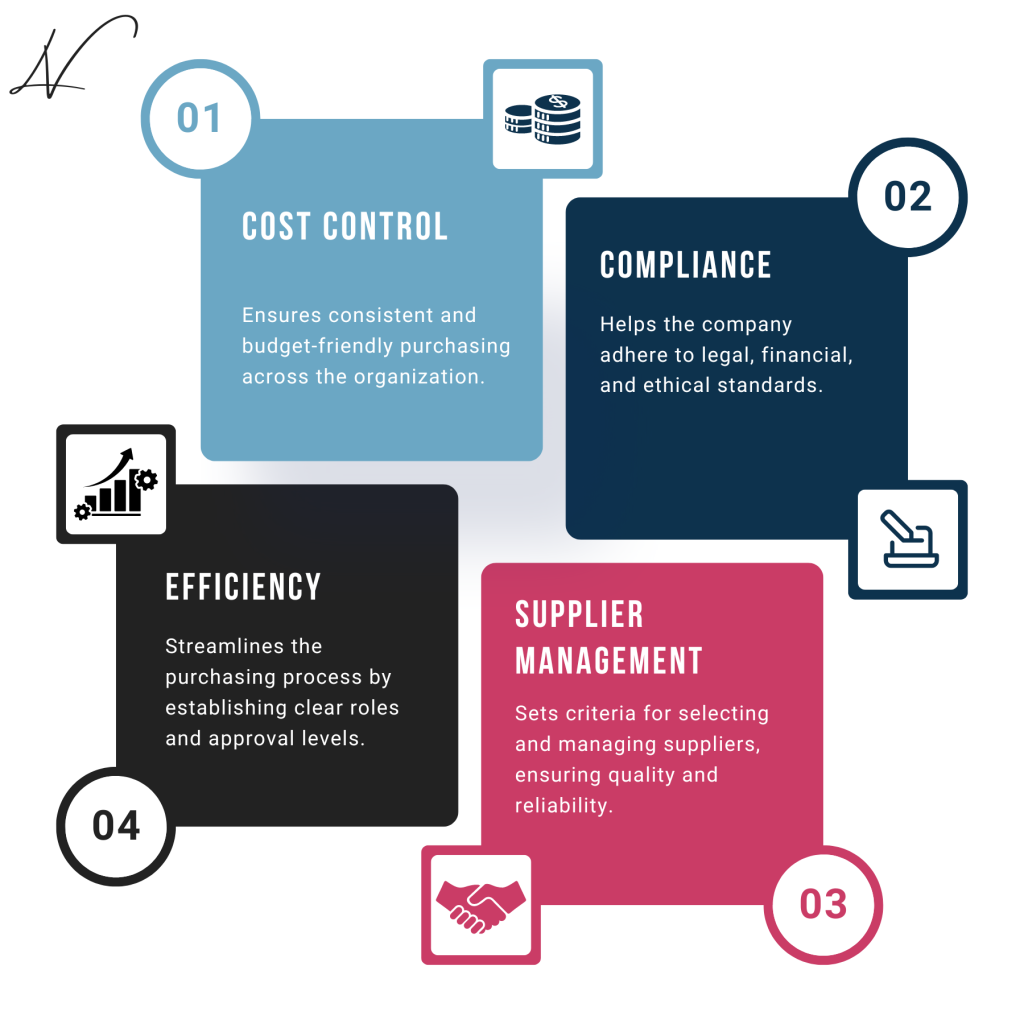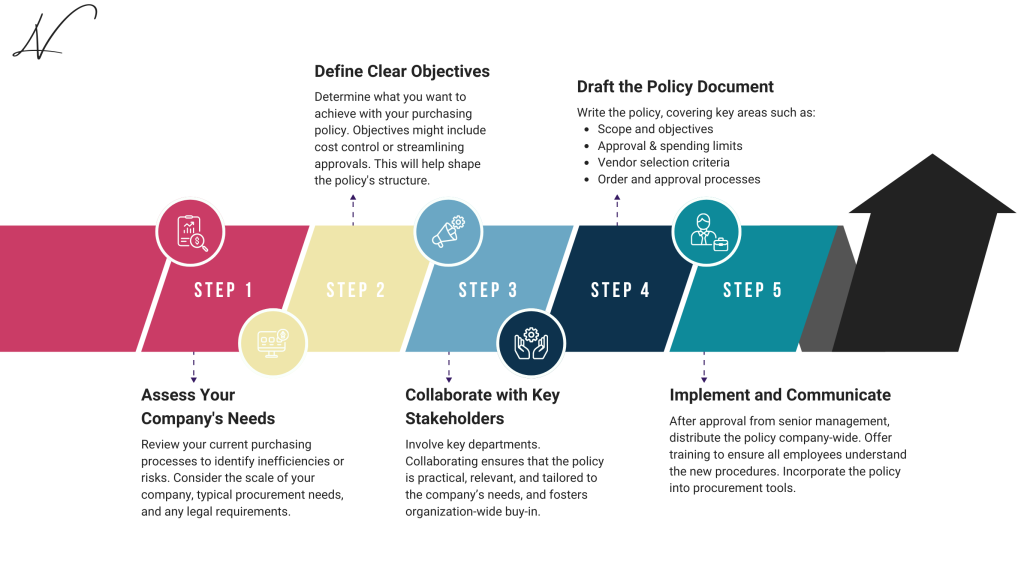As your company grows and more employees become involved in purchasing supplies, materials, or parts, it becomes crucial to streamline the procurement process. A purchasing policy serves as a foundational framework that helps ensure consistency, transparency, and compliance throughout this process. Without clear guidelines, employees may end up choosing different vendors for similar items, leading to inefficiencies and missed opportunities for cost savings. Some may rely on preferred suppliers, even when better deals exist elsewhere.
The importance of a purchasing policy
A well-defined purchasing policy is vital for several reasons:
Cost Control: It ensures consistent, cost-effective purchasing practices across the organization. By centralizing procurement, companies can leverage bulk purchasing, negotiate better deals, and ultimately reduce costs.
Compliance: A purchasing policy helps the company adhere to legal, financial, and ethical standards. This is particularly crucial for companies operating in multiple jurisdictions or industries with strict regulatory requirements.
Efficiency: By streamlining the purchasing process with clear roles, responsibilities, and approval workflows, a purchasing policy minimizes delays and confusion. Employees know exactly what steps to take, reducing the time spent on procurement.
Supplier Relationship Management: The policy establishes criteria for selecting and managing suppliers to guarantee quality and reliability. By focusing on supplier performance and relationships, companies can foster better collaboration and communication.

When should a company draft a purchasing policy?
A purchasing policy should be implemented under several circumstances:
- Expansion: When a company is expanding and needs to centralize procurement, it becomes essential to draft a purchasing policy to maintain control over spending and supplier choices.
- Risk of Unregulated Purchases: If there is a risk of unregulated or duplicate purchases, a purchasing policy can help standardize practices and reduce waste.
- Regulatory Compliance: When regulatory requirements demand compliance, having a purchasing policy in place is crucial for navigating complex legal landscapes.
Typically, companies introduce a purchasing policy when ad-hoc purchasing becomes unsustainable or when better control over spending across multiple departments is needed.
Who should draft the purchasing policy?
Usually, the finance or procurement team drafts the policy in collaboration with the legal, compliance, and department heads. This collaborative approach ensures that all relevant stakeholders have input and can help identify potential issues before the policy is finalized. The document should be thorough yet straightforward so that all employees can easily understand and follow it.
Who should approve and sign it?
Once drafted, the purchasing policy needs approval from senior management—typically the CEO or CFO, depending on the organization’s structure. Key stakeholders who will enforce the policy should also sign the document to ensure accountability. This sign-off not only legitimizes the policy but also reinforces its importance across the organization.
How to distribute and implement YOUR policy ?
Distribution: After approval, share the policy across the company via email, post it on internal platforms, or include it in onboarding materials. Ensure that everyone in the organization knows where to find the policy and understands its importance.
Training: Provide training sessions to ensure all employees, particularly those involved in purchasing, understand the policy and know how to apply it. Training can include real-life scenarios, Q&A sessions, and practical examples to reinforce learning.
Technology Integration: Consider using procurement software to embed the policy and facilitate compliance and tracking throughout the purchasing process. Technology can automate approvals, track spending, and provide analytics to ensure adherence to the policy.

Example of key sections
Here are some key sections that should be included in a comprehensive purchasing policy:
- Objective: Defines the purpose and scope of the policy, explaining why it exists and what it aims to achieve.
- Approval Matrix: Details spending limits and required approvals for various levels, ensuring that all purchases go through the appropriate channels.
- Vendor Selection Criteria: Specifies how to evaluate and choose suppliers based on quality, reliability, pricing, and compliance with ethical standards.
- Order Process: Outlines the steps employees must follow to make purchases, from request to approval to final procurement. This section should also clarify the roles of various team members in the process.
Policy updates
A purchasing policy is not a ‘set it and forget it’ document. It should evolve alongside the company’s needs, market trends, and new technology solutions like AI-driven procurement tools. Regular updates to the policy help maintain its relevance and effectiveness. Here are some key factors to consider when planning policy updates:
- Market Changes: The procurement landscape is continually shifting due to fluctuations in market prices, availability of materials, and supplier dynamics. Regularly reviewing your purchasing policy can help ensure that your company remains competitive and cost-effective.
- Feedback from Users: Gathering feedback from employees who engage with the purchasing process can uncover practical challenges and insights, leading to necessary policy adjustments.
- Regulatory Compliance: As laws and regulations change, it’s crucial to update your purchasing policy to maintain compliance and avoid potential penalties.
- Technological Advances: Incorporating new technologies, such as e-procurement systems or automated approval workflows, can streamline the purchasing process. Make sure your policy reflects these changes.
- Supplier Performance: Regular evaluations of supplier performance can inform necessary adjustments in supplier selection criteria and relationship management practices.
When to update your policy:
- Annually, or more frequently if significant changes occur.
- After major company events, such as mergers or acquisitions, which may alter procurement practices.
- Following a compliance audit or internal review when gaps in the policy may have been identified.
FAQs or Common Mistakes
Why is it essential to involve key stakeholders from all departments ?
Involving stakeholders ensures that the policy aligns with the needs of different departments and increases buy-in. When all teams feel their voices are heard, it fosters a culture of compliance and cooperation.
What is a common mistake companies make when implementing a purchasing policy?
A frequent oversight is the lack of training for employees on the policy. Without proper understanding, employees may not follow the procedures correctly, leading to inconsistencies and compliance issues.
How often should it be reviewed?
Ideally, a purchasing policy should be reviewed at least annually or whenever significant changes occur in the business environment, regulatory landscape, or supplier relationships.
Can a purchasing policy be too rigid?
Yes, an overly strict policy can stifle flexibility and responsiveness to market changes. It’s crucial to find a balance between maintaining control and allowing room for strategic decision-making.
What role does data analysis play in purchasing policies?
Data analysis is vital for identifying spending patterns, evaluating supplier performance, and uncovering opportunities for cost savings. Incorporating data-driven insights can enhance the effectiveness of your purchasing policy.
How can technology aid in enforcing the policy?
Procurement software can automate compliance checks, facilitate approvals, and track spending against budgets, ensuring adherence to the policy while streamlining processes.
Conclusion
In summary, a well-crafted policy is essential for any growing company. It not only guides purchasing decisions but also fosters efficiency, compliance, and supplier relationship management. Regular updates and training ensure that the policy remains relevant and effective, while engaging all departments creates a culture of collaboration and accountability.
Are you looking to draft a purchasing policy but don’t know where to start? No worries, we’ve got you covered! Download our simple Purchasing Policy Template to help you get started.
Need more support to craft your Procurement Policy and learn procurement best practices? Book a free 30-minute consultation with me today!

![You are currently viewing What is a purchasing policy and why do private companies need one? [WITH TEMPLATE]](https://lolitaverite.com/wp-content/uploads/2024/10/Purchasing-policy.png)


